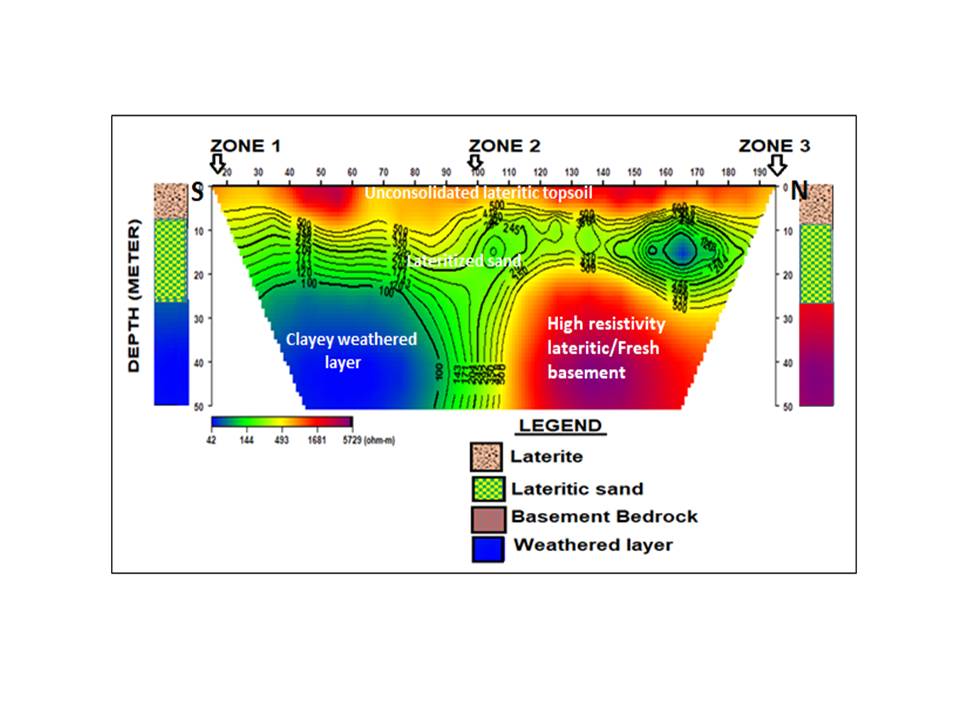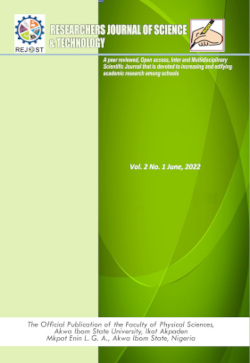Geoelectrical and Geotechnical based-assessment of Subsurface Soil Electrical Earthening Property and Corrosive Vulnerability along Coker Village Road, Osogbo, Nigeria
Keywords:
Electrical, Eartheing, Vulnerability, Corrosivity, Coker, ResistivityAbstract
This study integratesa geophysical and geotechnical approach tothe subsurface soil along Coker Village Road located about 200 meters from the Osun State University, Main Campus gate in Osogbo, Southwestern Nigeria. This is with the aim of assessing the subsurface electricalearthening properties and the corosivity of the soils within the study area.Twelve vertical electrical sounding (VES) surveys,one 2D Wenner profiling were collected, with four located 100 m apart from another four, while three cone penetration test measurements were collected at the midpoint of each of the four VES points to determine the in-situ shear strength properties. The VES data were interpreted using partial curve matching and later iterated using the DCInversion software, while the 2D Wenner profiling data were interpreted using the DiprofWin software. The corrosivity of the subsurface soil was inferred from appropriateclassification ranges of resistivity values, while the cone penetrometer data were interpreted using the Microsoft Excel spreadsheet.The results of the investigation reveal that there exist four to five geoelectric layers that alternate between lateritic topsoil with a resistivity ranging from 424.7 Ωm to 819.9 Ωm, lateritic layer with a resistivity rangingfrom 290.5 Ωm to 512.3 Ωm, and sandy bedrock with resistivity ranging from 265.9 Ωm to 1205.5 Ωm. All the first three geoelectric layers occur to a depth of more than 5 meters, possess a high shear stress to support the hosting of the mast, do not possess reliable earthing properties due to the high resistivity oflateritic subsurface materials and are practically non-corrosive with resistivity values above 180 Ωm. The result of 2D Wenner profiling showed that the topmost part of the study areais composed of high resistance materials, that extend from a minimum depth of 4-5 meters to a maximum depth of up to 12 meters.This study demonstrates the efficacy of integrating geophysical, geological, and geotechnical approaches in obtaining more information about the subsurface condition of the soil in the studied area as opposed to using only one technique. The study recommends that a conductive earth medium be created by using clay or salt (brine) chambers within the study area so as to make electrical conduction continuous.
References
AEMC. (2012). Understanding ground resistance testing. AEMC Instruments, USA; http:/www.aemc.com
Adejumo, S. A. (2015). Geo-electrical investigation of Groundwater Potential at the Polytechnic, Ibadan, North Campus Southwestern, Nigeria; https://www.-semanticscholar.org/
Agunloye, O. (1984). Soil aggressivity along Steel Pipeline route at Ajaokuta, Southwestern Nigeria. Nigerian Journal of Mining and Geology.Vol.21, Nos (1 & 2), pp. 97-101.http://www.sapub.org/-global/showpaperpdf.aspx?doi=10.5923/j.geo.20160601.02
Akintorinwa, O.J. and Adesoji, J. I. (2009) Application of Geological and Geotechnical Investigation in Engineering Site Evaluation. International Journal of Physical Sciences, 4, 443-454. https://www. scirp.org/%28S%-28lz5mqp453edsnp55rrgjct55%29%29/reference/referencespapers.aspx?referenceid=1295449.
ARTC. (2005). Lightning and surge protection requirements. Australian Rail Track Corporation; http://extranet.artc.com.au-/docs/eng/signal/ procedures/construction/-SCP04
Baldi, G., R. Bellotti, V. N. Ghionna, M. Jamiolkowski, and Lo Presti, D. C. F. (1989). “Modulusof sands from CPT’s and DMT’s.” In Proc., 12th Int. Conf. on Soil Mechanics and FoundationEngineerin, 165–170. Rio de Janeiro, Brazil: International Conference on Soil Mechanics and Foundation Engineering. http://www2.ing.unipi.it/geotecnica/08Software/User_Manual_CPT_PaGE.pdf
Barker, R. D. (1990). Investigation of Groundwater Salinity by Geophysical Methods. Geotechnical and Environmental Geophysics: Volume II, Environmental and Groundwater. https://library.seg.org /doi 10.1190/1.9781560802785.2.ch20.
Beackmann, W. V. and Schweak, W. (1976). Handbook of Cathodic Corrosion Protection Theoryand Practice of Electrochemical Protection Processes, Third Edition http:/www.sciencedirect.com/book/9780884150565/handbook-of-cathodic-corrosion-protection.
Burke, K., Freeth, S.J. and Grant, N. K. (1976). The structure and sequence of geological events in the basement complex of the Ibadan area, western Nigeria. Precambrian Research, 3, pp. 537 – 545. http://10.1016/0301-9268(76)90017-6
Eslaamizaad, S., Robertson, P. K. (1998). Cone penetration resistance of sand from seismic tests, in Robertson PK, Mayne PW, Eds., Geotechnical site characterization: Balkema, pp. 1027–1032. http://pascal-francis.inist.fr-/vibad/index.php?action=getRecordDetail&idt=6214143
LEM, (2005). Electrical grounding techniques,A 99415 E Publication, Ground Resistance –Principles, Testing, Techniques and Application.http://www.lem.com
Megger, C. (2005): Getting down to Earth, A practical guide to earth resistance testing;http:/pdf4pro.com/view/a-practical-guide-to-earth-resistance-testing-273f4b.html
Obaje, N.G. (2009). Geology and Mineral Resources of Nigeria, Springer Books.USA pp.15-35 https://link.springer.com/book-/10.1007/978-3-540-92685-6
Ofomola, M. O., Adiat, K. A. N., Olayanju, G. M. and Ako, B. D. (2009). Integrated Geophysical Methods for Post Foundation Studies, Obanla Staff Quarters of the Federal University of Technology, Akure, Nigeria. The Pacific Journal of Science and Technology, 10 (2): 333 – 359. http://www.-akamaiuniversity.us/PJST.htm
Oladele, S., Oyedele, K. F, Dinyo, M.O (2015). Pre-construction geoelectrical and geotechnical assessment of an engineering site at Alapere/Agboyi, Lagos, Nigeria”. Ife J. Sci. 17(3).543-552. http://ijs.oauife.-edu.ng/wp-content/uploads/2016/01/Oladele-et-al-2.pdf
Olayanju, G. M. and Onaolapo, F. O. (2015): Geoelectrical investigation for subsurface electrical system earthing at the School of Management Technology of the Federal University of Technology, Akure, Nigeria; Journal of Science and Technology, Kwame Nkrumah University of Science and Technology (KNUST); Vol. 35, No. 1, pp10-23 10. http://dx.doi.org/10.4314/just.v35i1.2
Olusegun, O. A., Ojo, A.O., Akinpelu, D. F. (2016). Geophysical investigation for groundwater potential and aquifer protective capacity around Osun State University (UNIOSUN) College of Health Sciences. American Journal of Water Resources.2016, 4(6), 137-143. http://pubs.sciepub.com-/ajwr/4/6/3/index.html
Oyedele, K. F and Olorode, D. O. (2010). Site Investigations of Subsurface Conditions Using Electrical Resistivity Method and Cone Penetration Test at Medina Estate, Gbagada,Lagos, Nigeria. World Applied Sciences Journal, 11, (9): 1097-1104. https:- //ir.unilag.edu.ng/items/7220ec6a-a0d6-48f1-a0fa-9300d604c058.
Oyinloye, A. O. (1998). Geology, geochemistry and origin of the banded and granite gneisses in the basement complex of the Ilesha area, southwestern Nigeria. Journal of African Earth Sciences, http://10.1016/S0899-5362(98)00037-2.
Oyinloye, M. A. and Kufoniyi, O. (2011) Analysis of Landuse Landcover Change and Urban Expansion in Akure, Nigeria. Journal of Innovative Research in Engineering and Sciences, 2, 234-248 https://journal-database.info/articles/analysis_landuse_landcover_change.html
Pfieffer, J. C. (2001). Principles of electrical grounding; Pfeiffer Engineering Co., Inc. https://pdf4pro.com/amp/download?data_id=f3056&slug=principles-of-electrical-grounding-pfeiffer
Rahaman, M.A. and Ocan, O. O. (1978). On relationship in the Precambrian Migmatite gneisses of Nigeria. Journal of Mining and Geology; Vol. 15, No.1. (23-30). https://-nmgs journal.org/?s=Rahaman%2C-+M.A.+and+Ocan%2C+O.O.
Rhett, H. (2001). An Introduction to Electrical Resistivity in Geophysics. American Journal of Physics,69, 943-952. http://ojps.aip.org/-ajp/ https://doi.org/10.1119/1.1378013.
United Nations Human Settlements Programme (UN-HABITAT). (2014) Structure Plan for Osogbo Capital Territory And Environs (2014 – 2033). https://unhabitat.org/sites/-default/files/2020/09/osogbo_print_final.pdf
Woakes, M., Rahaman, M. A., Ajibade, A. C. (1987). Some metallogenetic features of the Nigerian basement. Journal of African Earth Science. 6: 54–64. https://www.semantic-scholar.org/-paper; doi:10.10160899-5362(87)90004-2

Downloads
Published
How to Cite
Issue
Section
License
Copyright (c) 2024 Researchers Journal of Science and Technology

This work is licensed under a Creative Commons Attribution-NonCommercial-NoDerivatives 4.0 International License.




